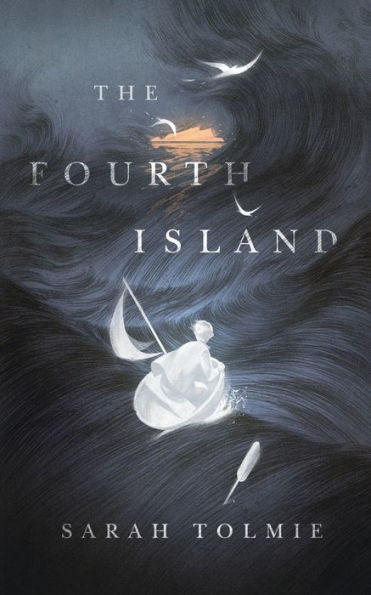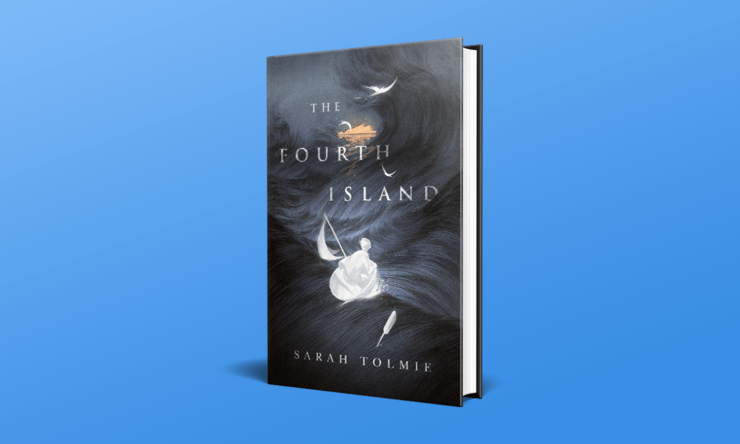Often books are like tides. The plot comes in waves, leaving characters half-buried in the sand. In order to find the seashells, skulls, strangely twisted driftwood amid the seaweed and salt, you must have a keen eye. It might take a few passes across a small, strange stretch of beach or stone or mud but these liminal places are the only place a sea, or a story, willingly lets go of its dead.
The Fourth Island is like a dark tide. It flows in and out of time, history, and myth, creating a picture of the Aran Islands that is deeply enmeshed in Irish culture.
The book focuses on the inhabitants of a fictional fourth Aran Island, Innis Caillte, over a generation of appearances and disappearances. Tolmie’s lyric prose pulls us through, not a riptide, but an undertow through the entire piece. Her command of dialect and description is wonderfully grounded Gaelic experience, full of turns of phrase and idiom that enmesh you in the environment of The Fourth Island. It is a novella about loss and sadness, a current that pulls you under, but often left me struggling.
There is no way to find the island, as it is as lost as the people who reside upon it, but you can find yourself there purely by accident or circumstance, or by wholly magical means. This premise is fantastic and lovely; that by being lost, completely, you can find yourself in a place that feels delicately suited to your nature, outside of region or time. I truly enjoyed reading about how the characters found themselves so lost that they ended up on an island totally outside of their reckoning. Watching Nelly and John Coneeley, characters who more or less ‘washed up’ on Innis Caillte from Innis Mor, change while on the island was compelling, as they played off each other in different ways. The sentimental descriptions of mourning, horror, and dissatisfaction convinced me that each character deserved to be swept up onto Innis Caillte.
Buy the Book


The Fourth Island
I would have been satisfied with the mystery of appearance, but Tolmie, in the text, makes an attempt to quantify the nature of the magic and over-explains why only three or four folks across time ended up on the island, out of all the lost folks out there in the world. By doing so, she removes much of the mystery, creating a story that feels detached and out-of-touch, which ignores the whole world in favor of Ireland. The implication in The Fourth Island is that Inis Caillte is the only lost island where lost people go to. While focusing on Ireland, and Irish loss, specifically, is important, and in this piece was treated with respect, the broad-strokes explanations of Innis Caillte denies the magic of an entire colonized world haunted by loss and covered by the shadow of British Imperialism. If the mystery of Innis Caillte had been preserved, Tolmie would have left open the possibility of lost islands dotting each ocean, sound, and bay, each suited to the people that need it. Instead, there is only Inis Caillte.
There was a moment while reading The Fourth Island where I became acutely aware of the Irishness of the storytelling. While considering mysterious circumstances, a man contemplates what he would do should he see a man with a red face, with one eye huge and one eye as small as a raisin. This seems to be a reference to the boyishly handsome Cu Chulainn, a famed hero, who, when battle-rage possessed him, twisted up his face to appear quite monstrous. It is perhaps both a strength and a hindrance in The Fourth Island that it spoke of folklore but only in passing, that the narrative makes it more difficult for the audience to explore how Irish it is. The first hint of this Irishness is in the name of the island itself, as, of course, ‘Inis Caillte’ directly translated means Lost Island.
The novella is beautifully written, each word picked carefully, but half-in and half-out of the Gaeltacht Aran Islands, it feels its own distance very keenly. Subtlety, speaking in code, and working around arch phrasing is a huge part of Irish culture. Even now, Ireland is split between the English-held land of Northern Ireland and the Republic, and patriotism, republicanism, and loyalist speech could get you hurt if you’re in the wrong county. Speaking in insinuations and cross-purpose is a part of the experience of being Irish. This might feel new to readers unfamiliar with Ireland’s history, as Tolmie weaves in exceptionally small details and snippets of the culture.
The focus on the characters was a strength, as we learned of the lives and desires of the outcast whore, the revolutionary Father, and a casualty of Cromwell’s march into the Irish interior, among others. Exploring the humans of The Fourth Island was exceptionally entertaining, and I enjoyed a lot of the quirks that were added onto each character as we unpacked their histories both on and off Innis Caillte.
Unfortunately, because of the shortness of the book, and the exceptionally keen focus on the rich interiority of the characters, the plot feels as isolated as the premise. The larger story often fades as Tolmie concentrates on each character. Throughout The Fourth Island, the story returns to the largest Aran Island, Innis Mor, and the mythology of Innis Caillte fades into the background as well. The magic of Innis Caillte that drew all these characters onto the island becomes more and more removed, and the book’s loss of the magic is much like a low tide, one that leaves all the old bones exposed.
While I often found myself wanting more from the story itself, I cannot deny that The Fourth Island is a beautifully crafted and exceptionally arranged novella. The piece is profoundly Irish, so much so that it feels acutely removed from understanding if you’re not Irish, or if you haven’t spent years reading Irish literature and poetry. However, scholars (or even fans) of Irish work will be rewarded with poesy that reflects the stylings of poets like Heaney, Yeats, and even the modern author Theo Dorgan; with easy comparisons being drawn between Dorgan’s seafaring adventures and the trial one of the characters survives on his sail to Innis Caillte.
Tolmie’s romantic voice appears on the page as she parcels out the story in generations and lives, giving strength and vibrancy to the individual, but ignoring the island’s story. The novella often reads like a eulogy to the past, coveting a time of both revolution and peace. The ironies layered into the narrative reflect the contradictions of Ireland itself, creating an indecipherable pattern within the characters and their interactions. Someone with a stronger grasp of Irish history than me could relate to each character a legend and history, Macha’s curse overlaid across a whore’s claim to a spinster’s house. Each small story in The Fourth Island contains an echo across insular Irish time, often leaving us, as readers, stranded on the unforgiving shores of Innis Caillte.
The Fourth Island is available from Tordotcom Publishing.
Linda H. Codega is an avid reader, writer, and fan. They specialize in media critique and fandom and they are also a short story author and game designer. Inspired by magical realism, comic books, the silver screen, and social activism, their writing reflects an innate curiosity and a deep caring and investment in media, fandom, and the intersection of social justice and pop culture. Find them on twitter @_linfinn.










